Abstract
Somatic mutation and neoplastic transformation of diploid Syrian hamster embryo cells were examined concomitantly. Mutations induced by benzo[a]pyrene and N-methyl-N′-nitro-N-nitrosoguanidine were quantitated at the hypoxanthine phosphoribosyltransferase and Na+/K+ ATPase loci and compared to phenotypic transformations measured by changes in cellular morphology and colony formation in agar. Both cellular transformations had characteristics distinct from the somatic mutations observed at the two loci. Morphological transformation was observed after a time comparable to that of somatic mutation but at a frequency that was 25- to 540-fold higher. Transformants capable of colony formation in agar were detected at a frequency of 10-5-10-6, but not until 32-75 population doublings after carcinogen treatment. Although this frequency of transformation is comparable to that of somatic mutation, the detection time required is much longer than the optimal expression time of conventionally studied somatic mutations. Neoplastic transformation of hamster embryo cells has been described as a multistep, progressive process. Various phenotypic transformations of cells after carcinogen treatment may represent different stages in this progressive transformation. The results are discussed in this context and the role of mutagenesis in the transition between various stages is considered. Neoplastic transformation may be initiated by a mutational change, but it cannot be described completely by a single gene mutational event involving a dominant, codominant, or X-linked recessive locus. Neoplastic transformation induced by chemical carcinogens is more complex than a single gene mutational process. Thus, this comparative study does not give experimental support to predictions of the carcinogenic potential of chemicals based on a simple extrapolation of the results obtained from conventional somatic mutation assays.
Keywords: chemical carcinogenesis, Syrian hamster, anchorage independence, morphological transformation, neoplastic progression
Full text
PDF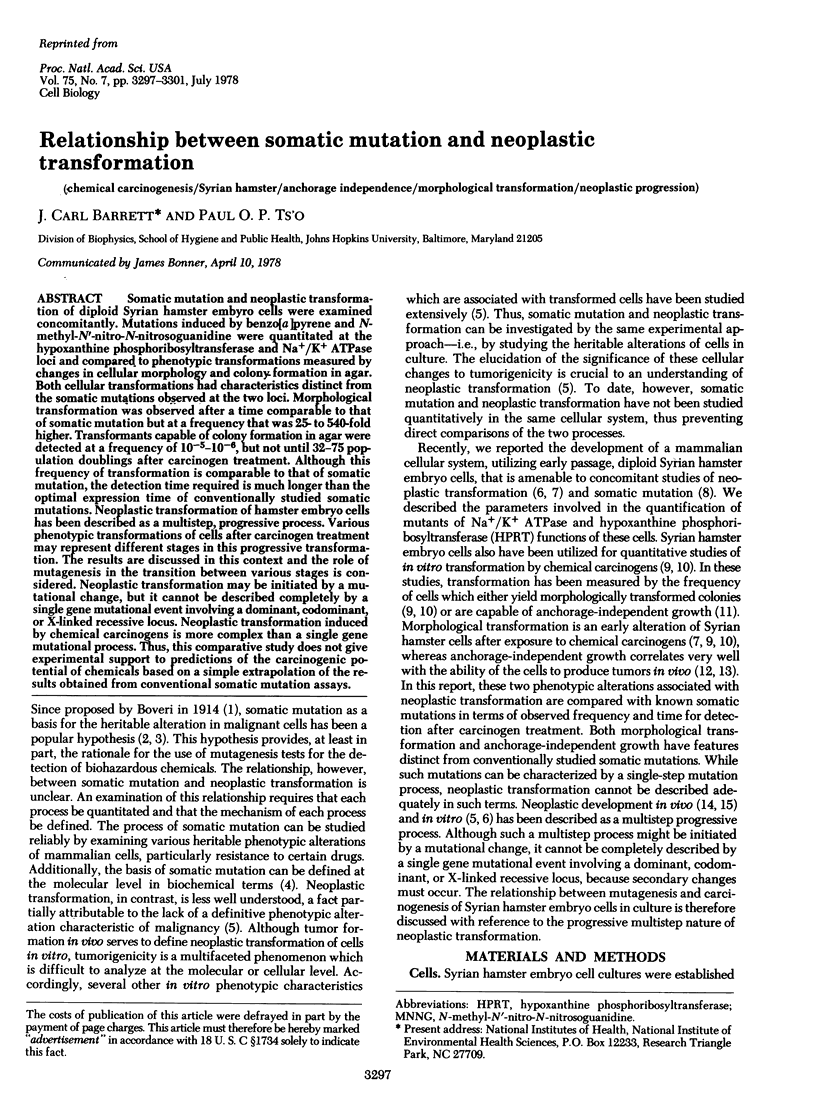
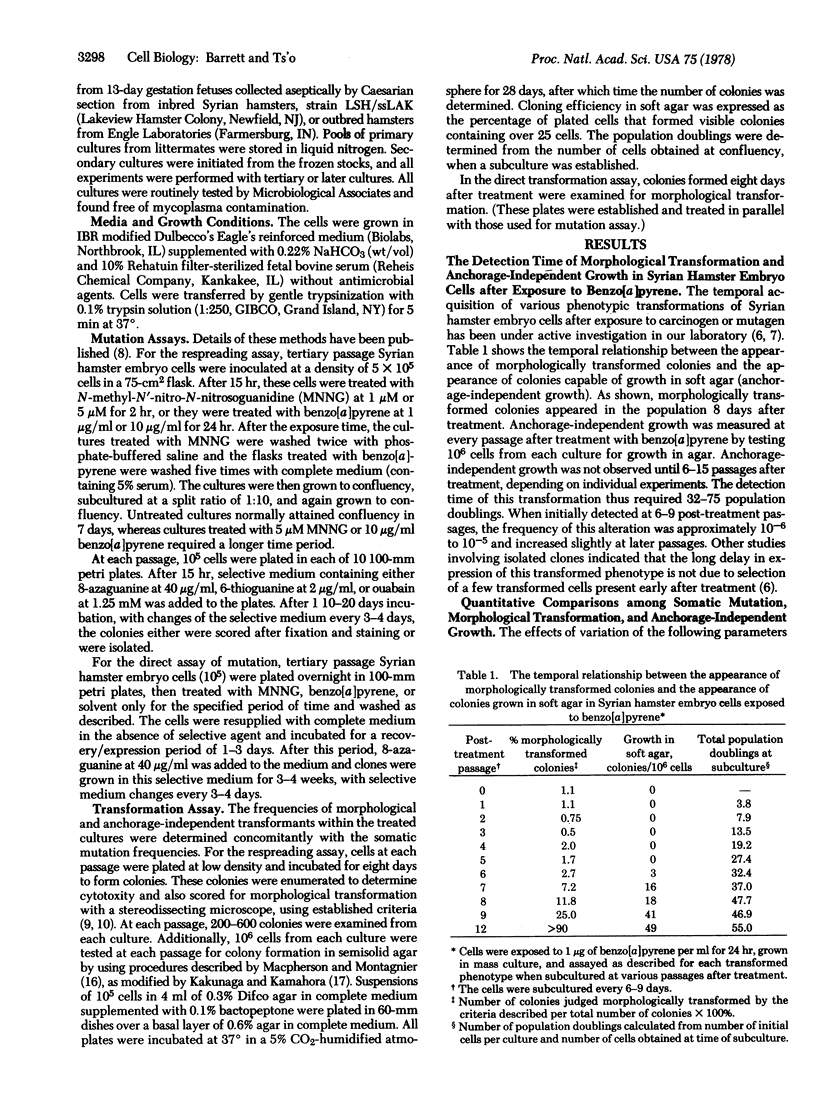
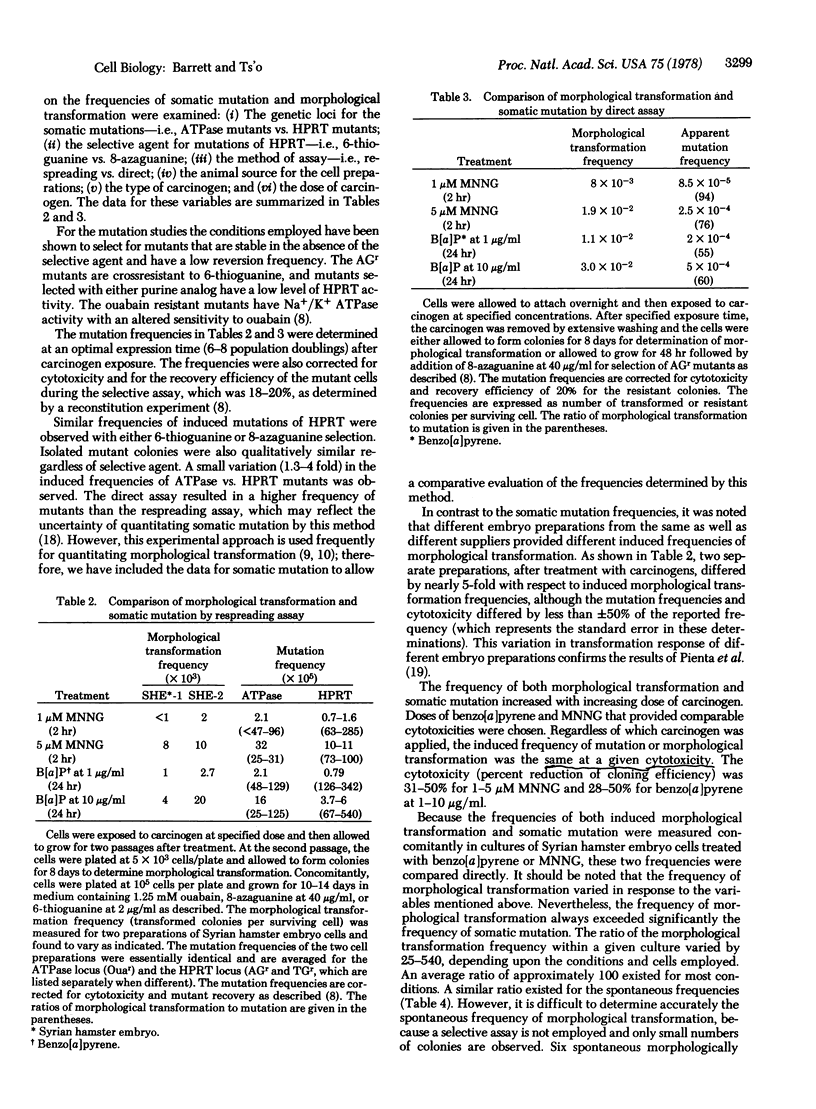
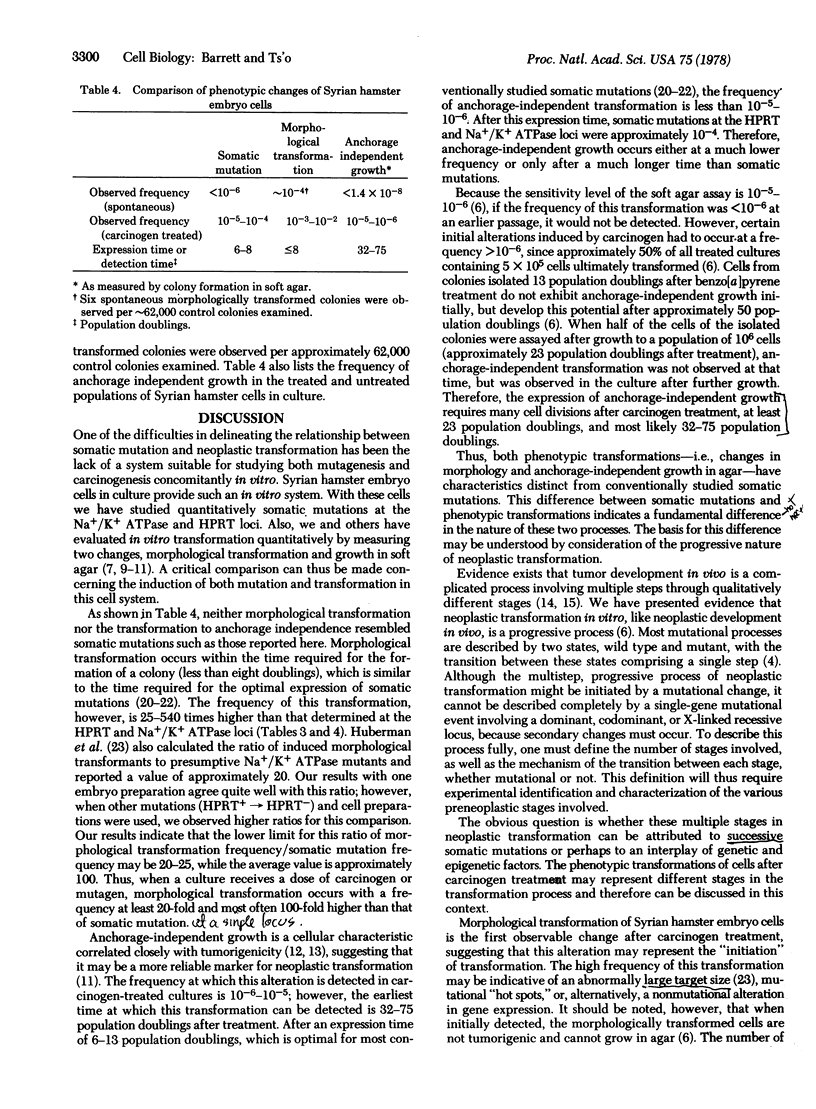
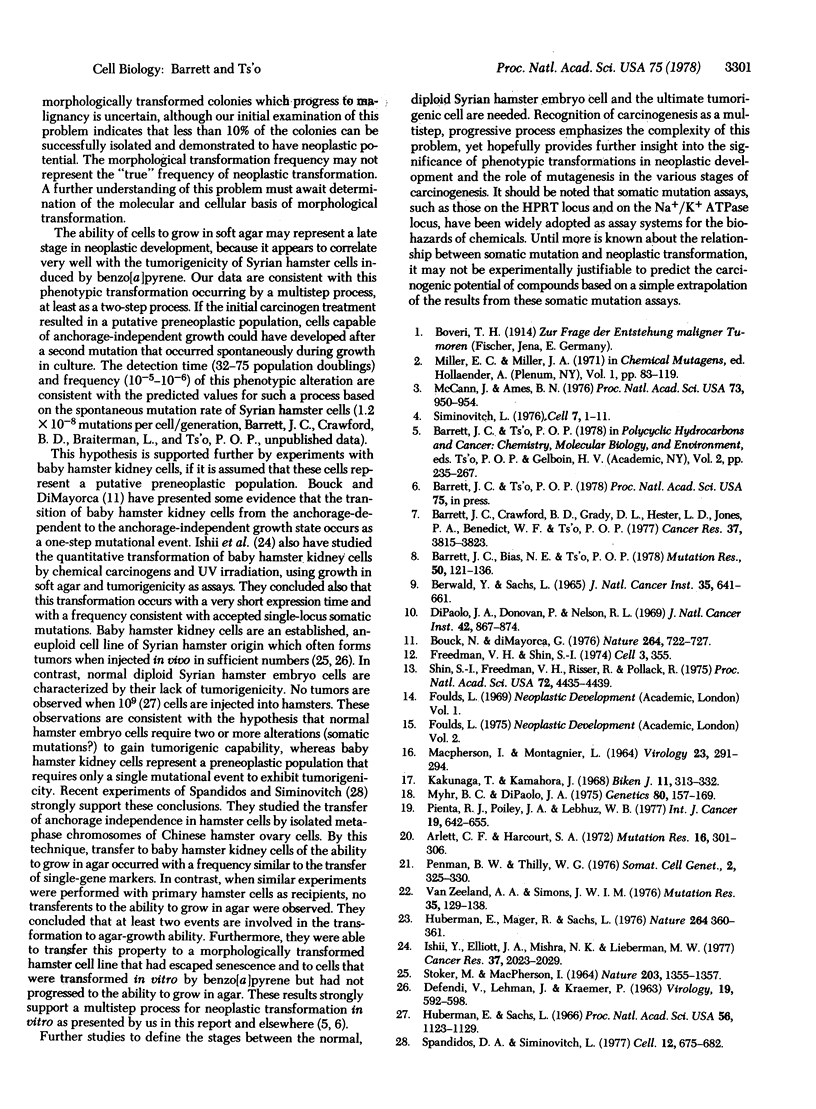
Selected References
These references are in PubMed. This may not be the complete list of references from this article.
- Arlett C. F., Harcourt S. A. Expression time and spontaneous mutability in the estimation of induced mutation frequency following treatment of Chinese hamster cells by ultraviolet light. Mutat Res. 1972 Nov;16(3):301–306. doi: 10.1016/0027-5107(72)90161-3. [DOI] [PubMed] [Google Scholar]
- Barrett J. C., Bias N. E., Ts'o P. O. A mammalian cellular system for the concomitant study of neoplastic transformation and somatic mutation. Mutat Res. 1978 Apr;50(1):121–136. doi: 10.1016/0027-5107(78)90067-2. [DOI] [PubMed] [Google Scholar]
- Barrett J. C., Crawford B. D., Grady D. L., Hester L. D., Jones P. A., Benedict W. F., Ts'o P. O. Temporal acquistion of enhanced fibrinolytic activity by syrian hamster embryo cells following treatment with benzo(a)pyrene. Cancer Res. 1977 Oct;37(10):3815–3823. [PubMed] [Google Scholar]
- Berwald Y., Sachs L. In vitro transformation of normal cells to tumor cells by carcinogenic hydrocarbons. J Natl Cancer Inst. 1965 Oct;35(4):641–661. [PubMed] [Google Scholar]
- Bouck N., di Mayorca G. Somatic mutation as the basis for malignant transformation of BHK cells by chemical carcinogens. Nature. 1976 Dec 23;264(5588):722–727. doi: 10.1038/264722a0. [DOI] [PubMed] [Google Scholar]
- DEFENDI V., LEHMAN J., KRAEMER P. "Morphologically normal" hamster cells with malignant properties. Virology. 1963 Apr;19:592–598. doi: 10.1016/0042-6822(63)90058-8. [DOI] [PubMed] [Google Scholar]
- DiPaolo J. A., Donovan P., Nelson R. Quantitative studies of in vitro transformation by chemical carcinogens. J Natl Cancer Inst. 1969 May;42(5):867–874. [PubMed] [Google Scholar]
- Freedman V. H., Shin S. I. Cellular tumorigenicity in nude mice: correlation with cell growth in semi-solid medium. Cell. 1974 Dec;3(4):355–359. doi: 10.1016/0092-8674(74)90050-6. [DOI] [PubMed] [Google Scholar]
- Huberman E., Mager R., Sachs L. Mutagenesis and transformation of normal cells by chemical carcinogens. Nature. 1976 Nov 25;264(5584):360–361. doi: 10.1038/264360a0. [DOI] [PubMed] [Google Scholar]
- Huberman E., Sachs L. Cell susceptibility to transformation and cytotoxicity by the carcinogenic hydrocarbon benzo[a]pyrene. Proc Natl Acad Sci U S A. 1966 Oct;56(4):1123–1129. doi: 10.1073/pnas.56.4.1123. [DOI] [PMC free article] [PubMed] [Google Scholar]
- Ishii Y., Elliott J. A., Mishra N. K., Lieberman M. W. Quantitative studies of transformation by chemical carcinogens and ultraviolet radiation using a subclone of BHK21 clone 13 Syrian hamster cells. Cancer Res. 1977 Jul;37(7 Pt 1):2023–2029. [PubMed] [Google Scholar]
- Kakunaga T., Kamahora J. Properties of hamster embryonic cells transformed by 4-nitroquinoline-1-oxide in vitro and their correlations with the malignant properties of the cells. Biken J. 1968 Dec;11(4):313–332. [PubMed] [Google Scholar]
- MACPHERSON I., MONTAGNIER L. AGAR SUSPENSION CULTURE FOR THE SELECTIVE ASSAY OF CELLS TRANSFORMED BY POLYOMA VIRUS. Virology. 1964 Jun;23:291–294. doi: 10.1016/0042-6822(64)90301-0. [DOI] [PubMed] [Google Scholar]
- McCann J., Ames B. N. Detection of carcinogens as mutagens in the Salmonella/microsome test: assay of 300 chemicals: discussion. Proc Natl Acad Sci U S A. 1976 Mar;73(3):950–954. doi: 10.1073/pnas.73.3.950. [DOI] [PMC free article] [PubMed] [Google Scholar]
- Myhr B. C., Dipalo J. A. Requirement for cell dispersion prior to selection of induced azaguanine-resistant colonies of Chinese hamster cells. Genetics. 1975 May;80(1):157–169. doi: 10.1093/genetics/80.1.157. [DOI] [PMC free article] [PubMed] [Google Scholar]
- Pienta R. J., Poiley J. A., Lebherz W. B., 3rd Morphological transformation of early passage golden Syrian hamster embryo cells derived from cryopreserved primary cultures as a reliable in vitro bioassay for identifying diverse carcinogens. Int J Cancer. 1977 May 15;19(5):642–655. doi: 10.1002/ijc.2910190508. [DOI] [PubMed] [Google Scholar]
- STOKER M., MACPHERSON I. SYRIAN HAMSTER FIBROBLAST CELL LINE BHK21 AND ITS DERIVATIVES. Nature. 1964 Sep 26;203:1355–1357. doi: 10.1038/2031355a0. [DOI] [PubMed] [Google Scholar]
- Shin S. I., Freedman V. H., Risser R., Pollack R. Tumorigenicity of virus-transformed cells in nude mice is correlated specifically with anchorage independent growth in vitro. Proc Natl Acad Sci U S A. 1975 Nov;72(11):4435–4439. doi: 10.1073/pnas.72.11.4435. [DOI] [PMC free article] [PubMed] [Google Scholar]
- Siminovitch L. On the nature of hereditable variation in cultured somatic cells. Cell. 1976 Jan;7(1):1–11. doi: 10.1016/0092-8674(76)90249-x. [DOI] [PubMed] [Google Scholar]
- Spandidos D. A., Siminovitch L. Transfer of anchorage independence by isolated metaphase chromosomes in hamster cells. Cell. 1977 Nov;12(3):675–682. doi: 10.1016/0092-8674(77)90267-7. [DOI] [PubMed] [Google Scholar]
- Van Zeeland A. A., Simons J. W. Linear dose--response relationships after prolonged expression times in V-79 Chinese hamster cells. Mutat Res. 1976 Apr;35(1):129–137. doi: 10.1016/0027-5107(76)90175-5. [DOI] [PubMed] [Google Scholar]


